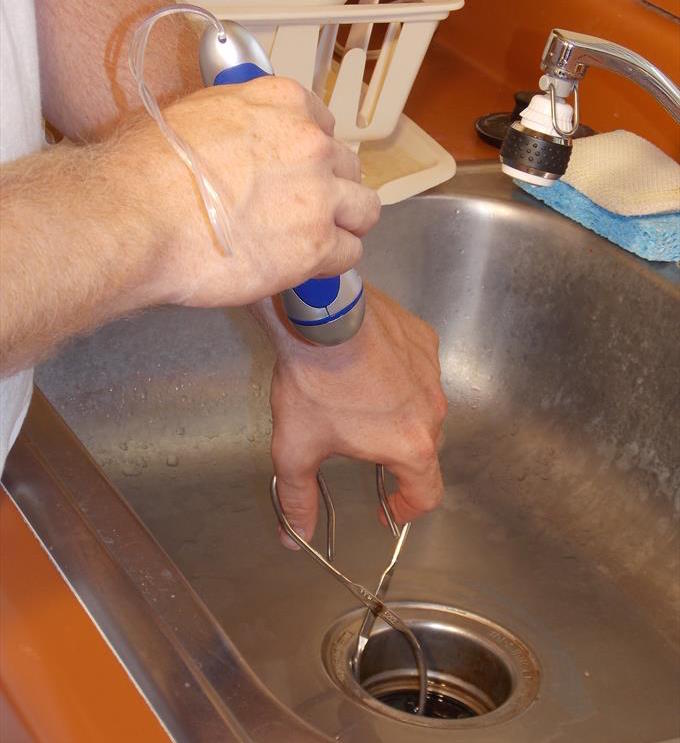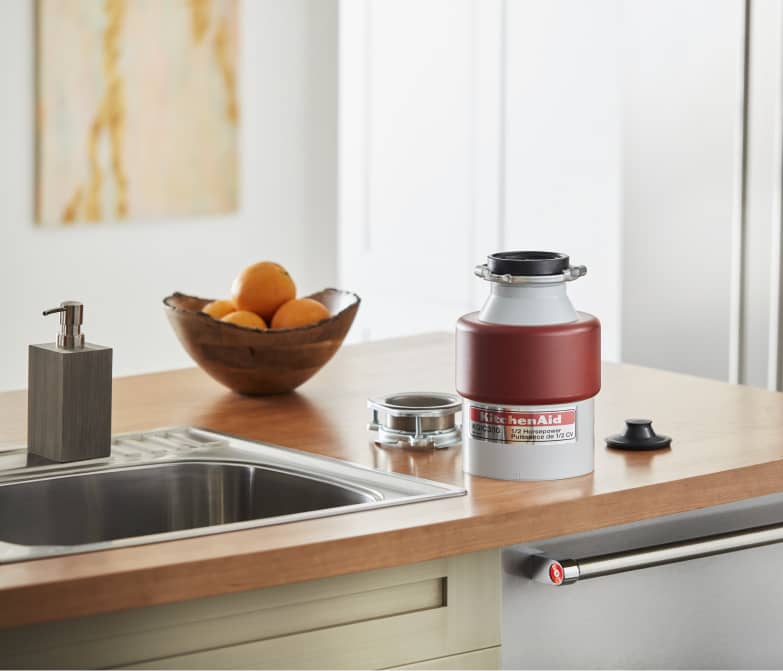
So you’re facing the dreaded clogged garbage disposal dilemma, huh? Don’t fret, my friend, because you’re about to discover some handy DIY methods to tackle this frustrating situation head-on. Whether it’s remnants of last night’s dinner or an accumulation of stubborn debris causing the blockage, there are a few simple tricks you can try before resorting to calling a plumber. So roll up your sleeves and let’s get down to business – unclogging that garbage disposal is easier than you think!

Detecting a clogged garbage disposal
If you’ve noticed that your garbage disposal is not working as efficiently as it used to, it’s possible that it might be clogged. While garbage disposals are designed to handle certain types of waste, they can still become clogged over time. There are a few signs that can help you determine if your garbage disposal is clogged:
Strange noises
One of the most common signs of a clogged garbage disposal is unusual noises coming from the unit. If you start to hear grinding or rattling sounds when you turn on your disposal, it could be a clear indication that there is a blockage somewhere in the system. These noises are usually caused by solid waste or debris getting stuck in the blades or impellers of the disposal.
Slow draining
Another sign of a clogged garbage disposal is slow draining in your sink. If you find that water is taking longer than usual to drain, even after running the disposal, it’s likely that there is a clog preventing proper drainage. This can be caused by a buildup of food particles and grease within the disposal.
Foul odor
A foul odor coming from your garbage disposal is not only unpleasant, but it could also be a sign of a clog. When food waste becomes trapped in the disposal, it can start to decompose and produce a strong, unpleasant smell. If you’ve noticed a lingering odor in your kitchen that seems to be coming from your disposal, it’s time to take action and unclog it.
Safety precautions before starting
Before you begin any DIY methods to unclog your garbage disposal, it’s important to take some safety precautions. Here are a few steps you should follow to ensure your safety:
Turn off the power
The first step in any garbage disposal maintenance or repair task is to turn off the power. This can be done by unplugging the disposal from the electrical outlet or turning off the circuit breaker that powers it. This is crucial to prevent any accidental injuries while working on the unit.
Avoid using chemicals
While it may be tempting to use chemical drain cleaners or other harsh substances to unclog your garbage disposal, it is strongly recommended to avoid them. These chemicals can damage the disposal and the pipes, and they may even be harmful to the environment. Stick to natural DIY methods instead.
Use tools with caution
If you decide to use tools to unclog your garbage disposal, make sure to use them with caution. Sharp objects, such as wrenches or pliers, should be used carefully to avoid causing any damage to the disposal or injuring yourself. Always follow the manufacturer’s instructions and exercise caution when working on the unit.

DIY methods to unclog a garbage disposal
Now that you know how to detect a clogged garbage disposal and have taken the necessary safety precautions, let’s explore some DIY methods you can try to unclog it. These methods are simple, effective, and can save you from calling a professional plumber.
Plunger method
The plunger method is a common and effective way to unclog a garbage disposal. Here’s how you can do it:
Step 1: Preparation
Before you begin, make sure the power to the disposal is turned off. Next, fill up the sink with enough water to cover the rubber flange of the plunger.
Step 2: Plunge the garbage disposal
Place the plunger over the drain opening and firmly press down to create a seal. Then, quickly and forcefully move the plunger up and down for about 20-30 seconds. This action will help dislodge any clogs and create suction to clear the blockage.
Step 3: Test the drain
After plunging, remove the plunger and turn on the power to the garbage disposal. Run water down the drain to check if the clog has been cleared. If the water drains smoothly, you have successfully unclogged your garbage disposal using the plunger method.
Baking soda and vinegar
Another DIY method you can try to unclog your garbage disposal is by using a combination of baking soda and vinegar. Here’s how you can do it:
Step 1: Pour baking soda
Start by pouring half a cup of baking soda down the drain. Make sure to distribute it evenly across the disposal.
Step 2: Add vinegar
Next, pour one cup of vinegar into the disposal. The vinegar will react with the baking soda, creating a foaming action that helps break up the clog.
Step 3: Allow the mixture to react
Let the baking soda and vinegar mixture sit in the disposal for about 10-15 minutes. This will give it enough time to work its magic and dissolve the clog.
Step 4: Flush with hot water
After the mixture has had time to react, turn on the hot water and flush it down the drain for a few minutes. The hot water will help wash away any remaining debris and clear the clog.
Boiling water
Using boiling water is another simple yet effective DIY method to unclog your garbage disposal. Here’s how you can do it:
Step 1: Boil water
Fill a kettle or pot with water and bring it to a boil on your stovetop. It’s important to use boiling water to help break up the clog and flush it away.
Step 2: Pour the boiling water into the garbage disposal
Once the water has come to a boil, carefully pour it into the garbage disposal. Start by pouring a small amount and then gradually increase the quantity while ensuring you don’t overflow the disposal. The boiling water will help dissolve the clog and flush it out.

P-trap cleaning
If the above methods haven’t been successful in unclogging your garbage disposal, it might be time to clean the P-trap. The P-trap is a U-shaped pipe located beneath the sink, and it can become clogged with food particles and debris. Here’s how you can clean the P-trap:
Step 1: Preparation
Start by placing a bucket or large bowl beneath the P-trap to catch any water or debris that may come out during the cleaning process. It’s important to have a container ready to prevent any mess.
Step 2: Loosen the slip nuts
Using pliers or a wrench, loosen the slip nuts on both ends of the P-trap. Be careful not to force them, as you don’t want to damage the pipes.
Step 3: Remove the P-trap
Once the slip nuts are loosened, carefully remove the P-trap from the pipe connections. Slowly tilt the trap to one side and allow any water or debris to drain into the container you placed beneath it.
Step 4: Clean the P-trap
Thoroughly clean the P-trap using a brush or a pipe cleaner to remove any accumulated food particles or debris. Take your time to ensure it is completely clear of any clogs.
Step 5: Reassemble the P-trap
After cleaning the P-trap, reattach it to the pipe connections by tightening the slip nuts. Make sure the connections are secure, but avoid over-tightening to prevent any damage.
Using a plumber’s snake
If all else fails, using a plumber’s snake can be a useful tool to unclog your garbage disposal. Here’s how you can use it:
Step 1: Gather the necessary tools
Before you begin, gather the necessary tools, including a plumber’s snake or auger, a bucket or bowl to catch any water, and gloves to protect your hands.
Step 2: Turn off the power
As always, ensure the power to the garbage disposal is turned off before attempting to use a plumber’s snake. Safety should always be a priority.
Step 3: Insert the plumber’s snake
Carefully insert the end of the plumber’s snake into the drain opening of the garbage disposal. Slowly push it in until you feel resistance, indicating that you have reached the clog.
Step 4: Rotate and push the snake
Once the snake is inserted, slowly rotate it in a clockwise motion while applying gentle pressure. This will help loosen and break up the clog. Continue pushing the snake further into the disposal and rotating it as needed.
Step 5: Repeat if necessary
If the snake does not completely clear the clog on the first attempt, slowly withdraw it from the drain and remove any debris that may have been dislodged. Repeat the process until you are confident the clog has been cleared.

Preventing future clogs
Now that you have successfully unclogged your garbage disposal using DIY methods, it’s important to take steps to prevent future clogs. Here are some tips to help you keep your garbage disposal running smoothly:
Run cold water while using the disposal
Whenever you use the garbage disposal, make sure to run cold water simultaneously. This helps to solidify grease and oils, making them easier to break down and flush away.
Avoid certain food items
To prevent clogs, avoid putting certain food items down the garbage disposal. Items such as fibrous vegetables, coffee grounds, eggshells, bones, and pasta can all cause clogs or damage to the disposal.
Regular cleaning and maintenance
Perform regular cleaning and maintenance on your garbage disposal to keep it operating efficiently. Regularly flush it with hot water, use a scrub brush to clean the blades, and ensure there are no lingering food particles after each use.
Professional check-ups
Consider scheduling regular check-ups with a professional plumber to inspect and maintain your garbage disposal. They can identify any potential issues and provide guidance on proper usage and maintenance.
Conclusion
In conclusion, a clogged garbage disposal can be a frustrating and inconvenient issue to deal with. However, with the right knowledge and DIY methods, you can often unclog it yourself without having to call a professional. By following the steps outlined in this article, you can effectively detect and unclog your garbage disposal, ensuring it continues to function smoothly. Remember to always prioritize your safety, use caution when using tools, and take preventive measures to avoid future clogs.






